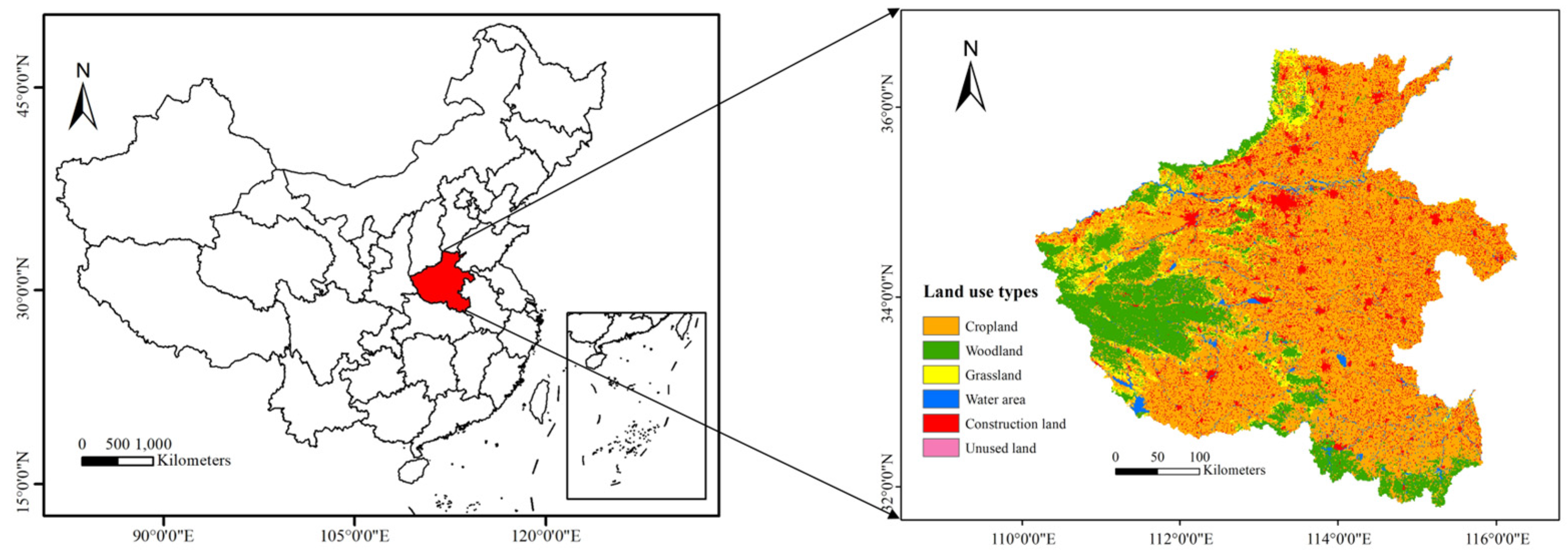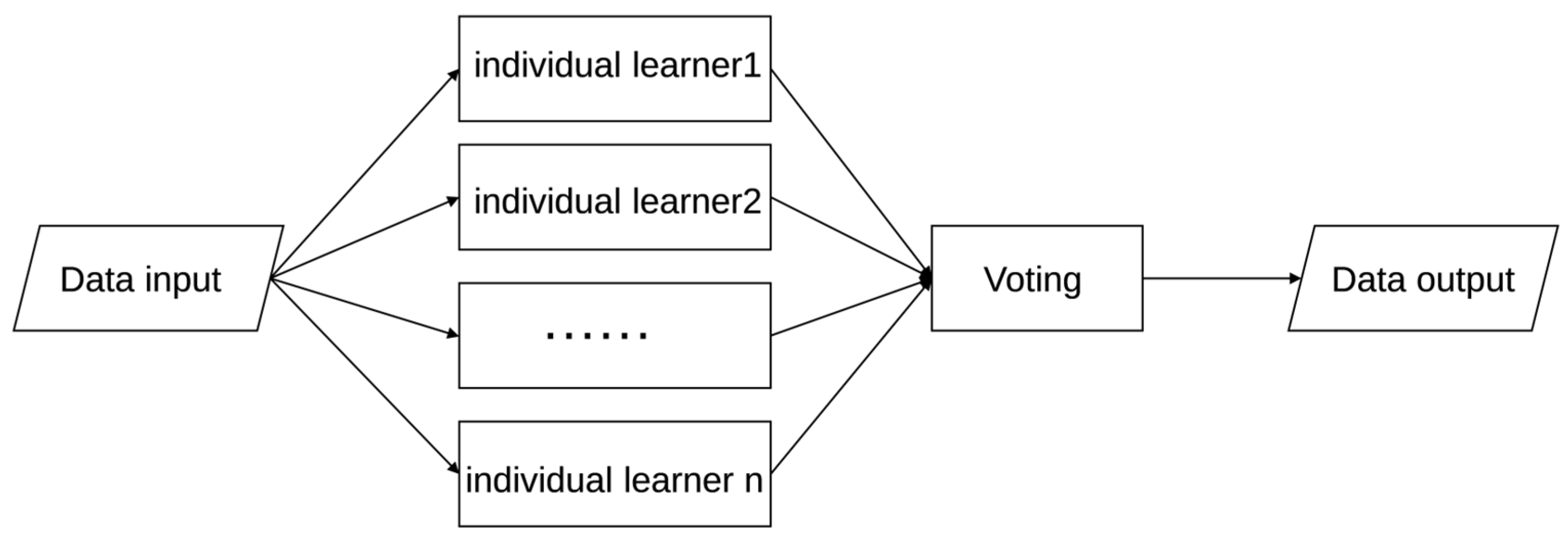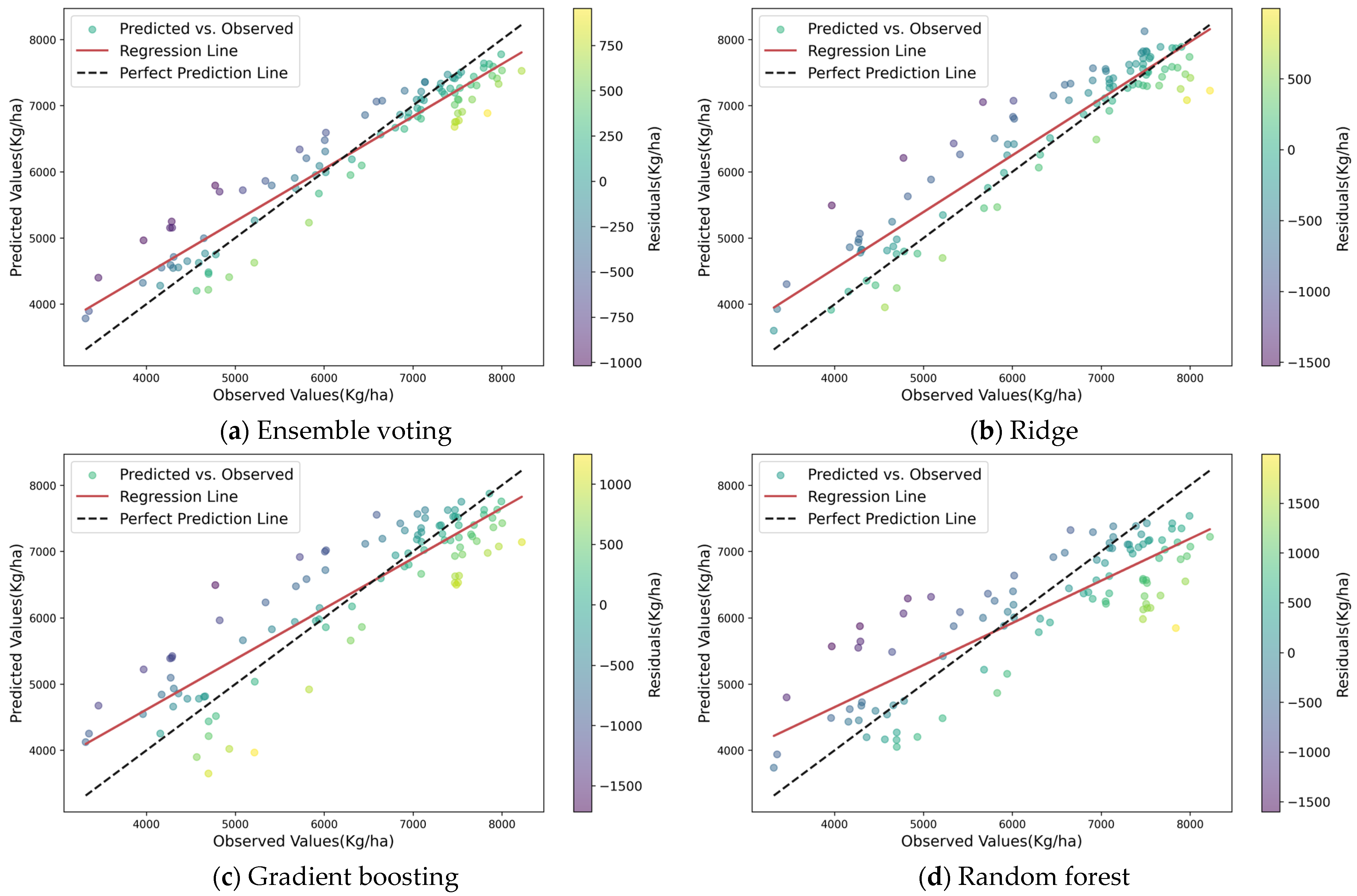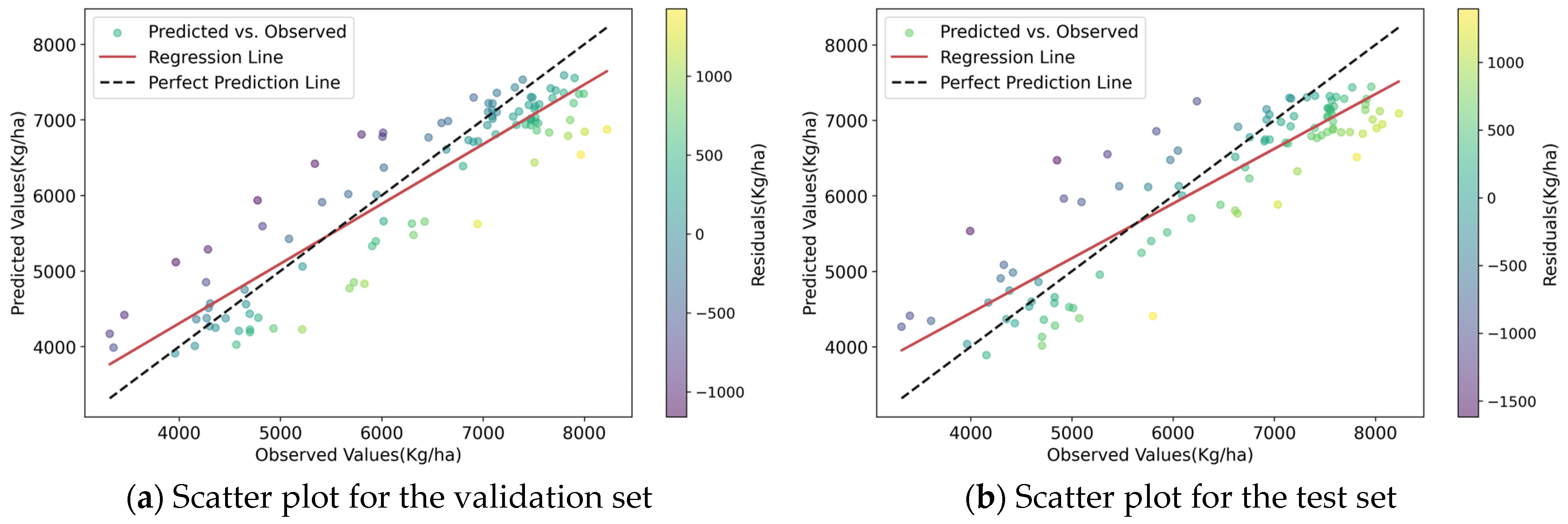Yield Prediction of Winter Wheat at Different Growth Stages Based on Machine Learning
Abstract
1. Introduction
2. Materials and Methods
2.1. Study Area
2.2. Data and Pre-Processing
2.2.1. Statistical Data
2.2.2. Winter Wheat Vector Data and Phenological Periods
2.2.3. Remote Sensing Data
2.3. Machine Learning Methods for Yield Prediction
2.3.1. Linear Models and Regularization Methods
2.3.2. Decision Tree Models and Their Extensions
2.3.3. Distance-Based Models
2.3.4. Support Vector Regression Models
2.3.5. Ensemble Models
2.4. Winter Wheat Yield Prediction
2.5. Accuracy Assessment
2.6. Construction of Spatialization Model for Yield
3. Results
3.1. Comparison of Accuracy in Yield Prediction Algorithms for Entire Growth Period
3.2. Comparison of Accuracy in Yield Prediction Algorithms for Individual Growth Periods
3.3. Pixel-Level Spatialization of Yield
4. Discussion
4.1. Performance Comparison of Winter Wheat Yield Prediction Models
4.2. Analysis of Yield Prediction Potential for Individual Growth Periods
4.3. Analysis of Spatialization in Yield Research
5. Conclusions
Author Contributions
Funding
Data Availability Statement
Conflicts of Interest
References
- Tian, H.; Wang, P.; Tansey, K.; Han, D.; Zhang, J.; Zhang, S.; Li, H. A Deep Learning Framework under Attention Mechanism for Wheat Yield Estimation Using Remotely Sensed Indices in the Guanzhong Plain, PR China. Int. J. Appl. Earth Obs. Geoinf. 2021, 102, 102375. [Google Scholar] [CrossRef]
- Chen, P.; Li, Y.; Liu, X.; Tian, Y.; Zhu, Y.; Cao, W.; Cao, Q. Improving Yield Prediction Based on Spatio-Temporal Deep Learning Approaches for Winter Wheat: A Case Study in Jiangsu Province, China. Comput. Electron. Agric. 2023, 213, 108201. [Google Scholar] [CrossRef]
- Xu, X.; Gao, P.; Zhu, X.; Guo, W.; Ding, J.; Li, C.; Zhu, M.; Wu, X. Design of an Integrated Climatic Assessment Indicator (ICAI) for Wheat Production: A Case Study in Jiangsu Province, China. Ecol. Indic. 2019, 101, 943–953. [Google Scholar] [CrossRef]
- Zhuo, W.; Fang, S.; Gao, X.; Wang, L.; Wu, D.; Fu, S.; Wu, Q.; Huang, J. Crop Yield Prediction Using MODIS LAI, TIGGE Weather Forecasts and WOFOST Model: A Case Study for Winter Wheat in Hebei, China during 2009–2013. Int. J. Appl. Earth Obs. Geoinf. 2022, 106, 102668. [Google Scholar] [CrossRef]
- Ren, Y.; Li, Q.; Du, X.; Zhang, Y.; Wang, H.; Shi, G.; Wei, M. Analysis of Corn Yield Prediction Potential at Various Growth Phases Using a Process-Based Model and Deep Learning. Plants 2023, 12, 446. [Google Scholar] [CrossRef] [PubMed]
- Cao, J.; Zhang, Z.; Tao, F.; Zhang, L.; Luo, Y.; Han, J.; Li, Z. Identifying the Contributions of Multi-Source Data for Winter Wheat Yield Prediction in China. Remote Sens. 2020, 12, 750. [Google Scholar] [CrossRef]
- Li, L.; Wang, B.; Feng, P.; Li Liu, D.; He, Q.; Zhang, Y.; Wang, Y.; Li, S.; Lu, X.; Yue, C.; et al. Developing Machine Learning Models with Multi-Source Environmental Data to Predict Wheat Yield in China. Comput. Electron. Agric. 2022, 194, 106790. [Google Scholar] [CrossRef]
- Cao, J.; Wang, H.; Li, J.; Tian, Q.; Niyogi, D. Improving the Forecasting of Winter Wheat Yields in Northern China with Machine Learning–Dynamical Hybrid Subseasonal-to-Seasonal Ensemble Prediction. Remote Sens. 2022, 14, 1707. [Google Scholar] [CrossRef]
- Cai, Y.; Guan, K.; Lobell, D.; Potgieter, A.B.; Wang, S.; Peng, J.; Xu, T.; Asseng, S.; Zhang, Y.; You, L.; et al. Integrating Satellite and Climate Data to Predict Wheat Yield in Australia Using Machine Learning Approaches. Agric. For. Meteorol. 2019, 274, 144–159. [Google Scholar] [CrossRef]
- Madugundu, R.; Al-Gaadi, K.A.; Tola, E.; Edrris, M.K.; Edrees, H.F.; Alameen, A.A. Optimal Timing of Carrot Crop Monitoring and Yield Assessment Using Sentinel-2 Images: A Machine-Learning Approach. Appl. Sci. 2024, 14, 3636. [Google Scholar] [CrossRef]
- Kaur, P.; Harnal, S.; Tiwari, R.; Upadhyay, S.; Bhatia, S.; Mashat, A.; Alabdali, A.M. Recognition of Leaf Disease Using Hybrid Convolutional Neural Network by Applying Feature Reduction. Sensors 2022, 22, 575. [Google Scholar] [CrossRef]
- Nagaraju, M.; Chawla, P.; Upadhyay, S.; Tiwari, R. Convolution Network Model Based Leaf Disease Detection Using Augmentation Techniques. Expert Syst. 2022, 39, e12885. [Google Scholar] [CrossRef]
- Mishra, A.M.; Harnal, S.; Gautam, V.; Tiwari, R.; Upadhyay, S. Weed density estimation in soya bean crop using deep convolutional neural networks in smart agriculture. J. Plant Dis. Prot. 2022, 129, 593–604. [Google Scholar] [CrossRef]
- Khan, S.N.; Li, D.; Maimaitijiang, M. A Geographically Weighted Random Forest Approach to Predict Corn Yield in the US Corn Belt. Remote Sens. 2022, 14, 2843. [Google Scholar] [CrossRef]
- Proutsos, N.D.; Fotelli, M.N.; Stefanidis, S.P.; Tigkas, D. Assessing the Accuracy of 50 Temperature-Based Models for Estimating Potential Evapotranspiration (PET) in a Mediterranean Mountainous Forest Environment. Atmosphere 2024, 15, 662. [Google Scholar] [CrossRef]
- Guo, Y.; Wang, H.; Wu, Z.; Wang, S.; Sun, H.; Senthilnath, J.; Wang, J.; Robin Bryant, C.; Fu, Y. Modified Red Blue Vegetation Index for Chlorophyll Estimation and Yield Prediction of Maize from Visible Images Captured by UAV. Sensors 2020, 20, 5055. [Google Scholar] [CrossRef] [PubMed]
- Zhou, H.; Yang, J.; Lou, W.; Sheng, L.; Li, D.; Hu, H. Improving Grain Yield Prediction through Fusion of Multi-Temporal Spectral Features and Agronomic Trait Parameters Derived from UAV Imagery. Front. Plant Sci. 2023, 14, 1217448. [Google Scholar] [CrossRef] [PubMed]
- Zhou, X.; Zheng, H.B.; Xu, X.Q.; He, J.Y.; Ge, X.K.; Yao, X.; Cheng, T.; Zhu, Y.; Cao, W.X.; Tian, Y.C. Predicting Grain Yield in Rice Using Multi-Temporal Vegetation Indices from UAV-Based Multispectral and Digital Imagery. ISPRS J. Photogramm. Remote Sens. 2017, 130, 246–255. [Google Scholar] [CrossRef]
- Sun, J.; Di, L.; Sun, Z.; Shen, Y.; Lai, Z. County-Level Soybean Yield Prediction Using Deep CNN-LSTM Model. Sensors 2019, 19, 4363. [Google Scholar] [CrossRef] [PubMed]
- Wang, J.; Si, H.; Gao, Z.; Shi, L. Winter Wheat Yield Prediction Using an LSTM Model from MODIS LAI Products. Agriculture 2022, 12, 1707. [Google Scholar] [CrossRef]
- Tan, C.; Wang, D.; Zhou, J.; Du, Y.; Luo, M.; Zhang, Y.; Guo, W. Remotely Assessing Fraction of Photosynthetically Active Radiation (FPAR) for Wheat Canopies Based on Hyperspectral Vegetation Indexes. Front. Plant Sci. 2018, 9, 776. [Google Scholar] [CrossRef] [PubMed]
- Schwalbert, R.A.; Amado, T.; Corassa, G.; Pott, L.P.; Prasad, P.V.V.; Ciampitti, I.A. Satellite-Based Soybean Yield Forecast: Integrating Machine Learning and Weather Data for Improving Crop Yield Prediction in Southern Brazil. Agric. For. Meteorol. 2020, 284, 107886. [Google Scholar] [CrossRef]
- Khan, S.N.; Li, D.; Maimaitijiang, M. Using Gross Primary Production Data and Deep Transfer Learning for Crop Yield Prediction in the US Corn Belt. Int. J. Appl. Earth Obs. Geoinf. 2024, 131, 103965. [Google Scholar] [CrossRef]
- Peng, B.; Guan, K.; Pan, M.; Li, Y. Benefits of Seasonal Climate Prediction and Satellite Data for Forecasting U.S. Maize Yield. Geophys. Res. Lett. 2018, 45, 9662–9671. [Google Scholar] [CrossRef]
- Huber, F.; Yushchenko, A.; Stratmann, B.; Steinhage, V. Extreme Gradient Boosting for Yield Estimation Compared with Deep Learning Approaches. Comput. Electron. Agric. 2022, 202, 107346. [Google Scholar] [CrossRef]
- Zhang, L.; Zhang, Z.; Luo, Y.; Cao, J.; Xie, R.; Li, S. Integrating Satellite-Derived Climatic and Vegetation Indices to Predict Smallholder Maize Yield Using Deep Learning. Agric. For. Meteorol. 2021, 311, 108666. [Google Scholar] [CrossRef]
- Fei, S.; Hassan, M.A.; Xiao, Y.; Su, X.; Chen, Z.; Cheng, Q.; Duan, F.; Chen, R.; Ma, Y. UAV-Based Multi-Sensor Data Fusion and Machine Learning Algorithm for Yield Prediction in Wheat. Precis. Agric. 2023, 24, 187–212. [Google Scholar] [CrossRef]
- Ahmed, A.A.M.; Sharma, E.; Jui, S.J.J.; Deo, R.C.; Nguyen-Huy, T.; Ali, M. Kernel Ridge Regression Hybrid Method for Wheat Yield Prediction with Satellite-Derived Predictors. Remote Sens. 2022, 14, 1136. [Google Scholar] [CrossRef]
- Wang, Y.; Shi, W.; Wen, T. Prediction of Winter Wheat Yield and Dry Matter in North China Plain Using Machine Learning Algorithms for Optimal Water and Nitrogen Application. Agric. Water Manag. 2023, 277, 108140. [Google Scholar] [CrossRef]
- Pang, A.; Chang, M.W.L.; Chen, Y. Evaluation of Random Forests (RF) for Regional and Local-Scale Wheat Yield Prediction in Southeast Australia. Sensors 2022, 22, 717. [Google Scholar] [CrossRef]
- Kumar, S.; Attri, S.D.; Singh, K.K. Comparison of Lasso and Stepwise Regression Technique for Wheat Yield Prediction. J. Agrometeorol. 2019, 21, 188–192. [Google Scholar] [CrossRef]
- Son, N.-T.; Chen, C.-F.; Cheng, Y.-S.; Toscano, P.; Chen, C.-R.; Chen, S.-L.; Tseng, K.-H.; Syu, C.-H.; Guo, H.-Y.; Zhang, Y.-T. Field-Scale Rice Yield Prediction from Sentinel-2 Monthly Image Composites Using Machine Learning Algorithms. Ecol. Inform. 2022, 69, 101618. [Google Scholar] [CrossRef]
- Zhou, W.; Liu, Y.; Ata-Ul-Karim, S.T.; Ge, Q.; Li, X.; Xiao, J. Integrating Climate and Satellite Remote Sensing Data for Predicting County-Level Wheat Yield in China Using Machine Learning Methods. Int. J. Appl. Earth Obs. Geoinf. 2022, 111, 102861. [Google Scholar] [CrossRef]
- Zhao, Y.; Xiao, D.; Bai, H.; Tang, J.; Liu, D.L.; Qi, Y.; Shen, Y. The Prediction of Wheat Yield in the North China Plain by Coupling Crop Model with Machine Learning Algorithms. Agriculture 2023, 13, 99. [Google Scholar] [CrossRef]
- Zhao, Y.; Zhang, Y.; Yang, Y.; Li, F.; Dai, R.; Li, J.; Wang, M.; Li, Z. The Impact of Land Use Structure Change on Utilization Performance in Henan Province, China. Int. J. Environ. Res. Public Health 2023, 20, 4251. [Google Scholar] [CrossRef]
- Huang, J.; Zhou, L.; Zhang, F.; Hu, Z.; Tian, H. Responses of Yield Variability of Summer Maize in Henan Province, North China, to Large-Scale Atmospheric Circulation Anomalies. Theor. Appl. Clim. 2021, 143, 1655–1665. [Google Scholar] [CrossRef]
- Xie, Y.; Shi, S.; Xun, L.; Wang, P. A Multitemporal Index for the Automatic Identification of Winter Wheat Based on Sentinel-2 Imagery Time Series. GIScience Remote Sens. 2023, 60, 2262833. [Google Scholar] [CrossRef]
- Wang, Y.; Zhang, Y.; Zhang, R.; Li, J.; Zhang, M.; Zhou, S.; Wang, Z. Reduced Irrigation Increases the Water Use Efficiency and Productivity of Winter Wheat-Summer Maize Rotation on the North China Plain. Sci. Total Environ. 2018, 618, 112–120. [Google Scholar] [CrossRef]
- National Bureau of Statistics of China. Data and Statistics. National Bureau of Statistics of China. Available online: https://data.stats.gov.cn (accessed on 1 October 2022).
- Ronchetti, G.; Manfron, G.; Weissteiner, C.J.; Seguini, L.; Nisini Scacchiafichi, L.; Panarello, L.; Baruth, B. Remote Sensing Crop Group-Specific Indicators to Support Regional Yield Forecasting in Europe. Comput. Electron. Agric. 2023, 205, 107633. [Google Scholar] [CrossRef]
- Wang, X.; Huang, J.; Feng, Q.; Yin, D. Winter Wheat Yield Prediction at County Level and Uncertainty Analysis in Main Wheat-Producing Regions of China with Deep Learning Approaches. Remote Sens. 2020, 12, 1744. [Google Scholar] [CrossRef]
- Tian, L.; Wang, C.; Li, H.; Sun, H. Yield Prediction Model of Rice and Wheat Crops Based on Ecological Distance Algorithm. Environ. Technol. Innov. 2020, 20, 101132. [Google Scholar] [CrossRef]
- Khalaf, G.; Månsson, K.; Shukur, G. Modified Ridge Regression Estimators. Commun. Stat.-Theory Methods 2013, 42, 1476–1487. [Google Scholar] [CrossRef]
- Polat, K.; Guenes, S. A novel hybrid intelligent method based on C4.5 decision tree classifier and one-against-all approach for multi-class classification problems. Expert Syst. Appl. 2009, 36, 1587–1592. [Google Scholar] [CrossRef]
- Tian, H.; Cheng, L.; Wu, D.; Wei, Q.; Zhu, L. Regional Monitoring of Leaf ChlorophyII Content of Summer Maize by Integrating Multi-Source Remote Sensing Data. Agronomy 2023, 13, 2040. [Google Scholar] [CrossRef]
- Appelhans, T.; Mwangomo, E.; Hardy, D.R.; Hemp, A.; Nauss, T. Evaluating machine learning approaches for the interpolation of monthly air temperature at Mt. Kilimanjaro, Tanzania. Spat. Stat. 2015, 14, 91–113. [Google Scholar] [CrossRef]
- Song, J.; Zhang, L.; Jiang, Q.; Ma, Y.; Zhang, X.; Xue, G.; Shen, X.; Wu, X. Estimate the Daily Consumption of Natural Gas in District Heating System Based on a Hybrid Seasonal Decomposition and Temporal Convolutional Network Model. Appl. Energy 2022, 309, 118444. [Google Scholar] [CrossRef]
- Mienye, I.D.; Sun, Y. A Survey of Ensemble Learning: Concepts, Algorithms, Applications, and Prospects. IEEE Access 2022, 10, 99129–99149. [Google Scholar] [CrossRef]
- Sagi, O.; Rokach, L. Ensemble Learning: A Survey. WIREs Data Min. Knowl. Discov. 2018, 8, e1249. [Google Scholar] [CrossRef]
- Sankalpa, C.; Kittipiyakul, S.; Laitrakun, S. Forecasting Short-Term Electricity Load Using Validated Ensemble Learning. Energies 2022, 15, 8567. [Google Scholar] [CrossRef]
- Yulisa, A.; Park, S.H.; Choi, S.; Chairattanawat, C.; Hwang, S. Enhancement of Voting Regressor Algorithm on Predicting Total Ammonia Nitrogen Concentration in Fish Waste Anaerobiosis. Waste Biomass Valorization 2023, 14, 461–478. [Google Scholar] [CrossRef]
- Banfield, R.E.; Hall, L.O.; Bowyer, K.W.; Kegelmeyer, W.P. Ensemble Diversity Measures and Their Application to Thinning. Inf. Fusion 2005, 6, 49–62. [Google Scholar] [CrossRef]
- Hanicinec, M.; Mohr, S.; Tennyson, J. A Regression Model for Plasma Reaction Kinetics. J. Phys. D Appl. Phys. 2023, 56, 374001. [Google Scholar] [CrossRef]
- Phyo, P.-P.; Byun, Y.-C.; Park, N. Short-Term Energy Forecasting Using Machine-Learning-Based Ensemble Voting Regression. Symmetry 2022, 14, 160. [Google Scholar] [CrossRef]
- Natras, R.; Soja, B.; Schmidt, M. Ensemble Machine Learning of Random Forest, AdaBoost and XGBoost for Vertical Total Electron Content Forecasting. Remote Sens. 2022, 14, 3547. [Google Scholar] [CrossRef]
- Perros, N.; Kalivas, D.; Giovos, R. Spatial Analysis of Agronomic Data and UAV Imagery for Rice Yield Estimation. Agriculture 2021, 11, 809. [Google Scholar] [CrossRef]
- Sagan, V.; Maimaitijiang, M.; Bhadra, S.; Maimaitiyiming, M.; Brown, D.R.; Sidike, P.; Fritschi, F.B. Field-Scale Crop Yield Prediction Using Multi-Temporal WorldView-3 and PlanetScope Satellite Data and Deep Learning. ISPRS J. Photogramm. Remote Sens. 2021, 174, 265–281. [Google Scholar] [CrossRef]
- Xu, W.; Yang, W.; Chen, S.; Wu, C.; Chen, P.; Lan, Y. Establishing a Model to Predict the Single Boll Weight of Cotton in Northern Xinjiang by Using High Resolution UAV Remote Sensing Data. Comput. Electron. Agric. 2020, 179, 105762. [Google Scholar] [CrossRef]











| Phenology | Emergence | Tillering | Overwintering | Green-Up | Jointing | Heading | Milk Ripening | Maturation |
|---|---|---|---|---|---|---|---|---|
| Time | Late September to late October | Early November to early December | Mid-December to mid-February | Mid-February to mid-March | Mid-March to early April | Mid-April to late April | May | Early June to Late June |
| Category | Variables | Spatial Resolution | Temporal Resolution | Sources |
|---|---|---|---|---|
| Statistical data | Yield | County-level | Yearly | Statistical Yearbook [39] |
| Wheat area | ||||
| Vector data | Wheat | County-level | Yearly | Sentinel 2 Image Extraction |
| Vegetation index | EVI | 500 m | 8-day | MOD09A1 |
| NDVI | MOD09A1 | |||
| FPAR | MOD15A2H | |||
| LST | 1 km | MOD11A2 | ||
| Ecological data | GPP | 500 m | 8-day | MOD17A2H |
| LAI | MOD15A2H | |||
| Hydrological data | ET | 500 m | 8-day | MOD16A2 |
| PET |
| Models | Validation Data | Test Data | ||||
|---|---|---|---|---|---|---|
| R2 | RMSE | MAE | R2 | RMSE | MAE | |
| Elastic Net | 0.52 | 933.28 | 767.95 | 0.52 | 930.86 | 754.47 |
| Gradient Boosting | 0.78 | 631.74 | 507.25 | 0.78 | 633.30 | 462.28 |
| Random Forest | 0.69 | 756.39 | 611.46 | 0.75 | 676.49 | 517.72 |
| Ridge | 0.86 | 509.50 | 389.66 | 0.79 | 609.80 | 475.07 |
| Adaboost | 0.61 | 848.46 | 725.36 | 0.57 | 878.83 | 731.44 |
| KNeighbors | 0.61 | 847.14 | 685.25 | 0.63 | 821.96 | 614.30 |
| DecisionTree | 0.55 | 904.67 | 628.91 | 0.49 | 954.56 | 700.81 |
| ExtraTree | 0.32 | 1116.44 | 812.83 | 0.38 | 1054.95 | 752.55 |
| NuSVR | 0.25 | 1172.38 | 1036.04 | 0.26 | 1156.47 | 1021.89 |
| SVR | 0.03 | 1332.69 | 1165.48 | 0.04 | 1316.57 | 1161.38 |
| Ensemble Voting | 0.90 | 439.21 | 351.28 | 0.90 | 424.44 | 313.92 |
| Removed Model | Validation Data | Test Data | ||||
|---|---|---|---|---|---|---|
| R2 | RMSE | MAE | R2 | RMSE | MAE | |
| Gradient Boosting | 0.82 | 569.00 | 458.29 | 0.86 | 506.82 | 386.23 |
| Random Forest | 0.88 | 477.62 | 381.62 | 0.88 | 474.53 | 349.19 |
| Ridge | 0.77 | 652.50 | 526.04 | 0.78 | 636.83 | 470.86 |
| None (Initial Model) | 0.90 | 439.21 | 351.28 | 0.90 | 424.44 | 313.92 |
Disclaimer/Publisher’s Note: The statements, opinions and data contained in all publications are solely those of the individual author(s) and contributor(s) and not of MDPI and/or the editor(s). MDPI and/or the editor(s) disclaim responsibility for any injury to people or property resulting from any ideas, methods, instructions or products referred to in the content. |
© 2024 by the authors. Licensee MDPI, Basel, Switzerland. This article is an open access article distributed under the terms and conditions of the Creative Commons Attribution (CC BY) license (https://creativecommons.org/licenses/by/4.0/).
Share and Cite
Lou, Z.; Lu, X.; Li, S. Yield Prediction of Winter Wheat at Different Growth Stages Based on Machine Learning. Agronomy 2024, 14, 1834. https://doi.org/10.3390/agronomy14081834
Lou Z, Lu X, Li S. Yield Prediction of Winter Wheat at Different Growth Stages Based on Machine Learning. Agronomy. 2024; 14(8):1834. https://doi.org/10.3390/agronomy14081834
Chicago/Turabian StyleLou, Zhengfang, Xiaoping Lu, and Siyi Li. 2024. "Yield Prediction of Winter Wheat at Different Growth Stages Based on Machine Learning" Agronomy 14, no. 8: 1834. https://doi.org/10.3390/agronomy14081834
APA StyleLou, Z., Lu, X., & Li, S. (2024). Yield Prediction of Winter Wheat at Different Growth Stages Based on Machine Learning. Agronomy, 14(8), 1834. https://doi.org/10.3390/agronomy14081834





